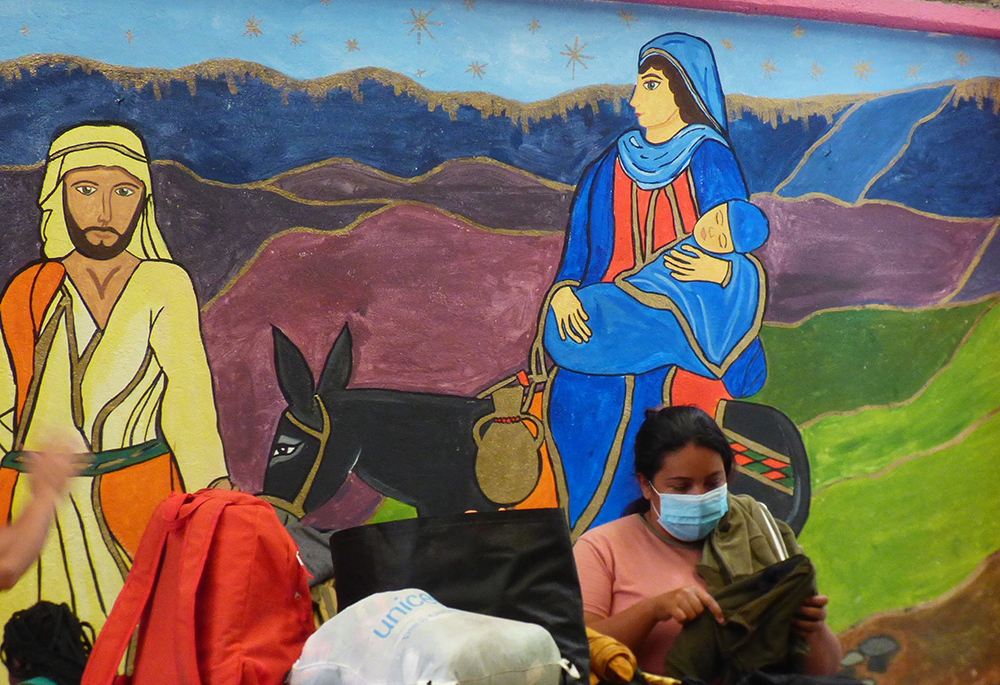
A woman gathers her belongings in front of a mural of Joseph and Mary at the CAFEMIN migrant shelter in Mexico City, Aug. 24. Sr. María Soledad Morales Ríos, one of the Josephine sisters whose congregation operates the shelter, said their charism is to care for the poor, including migrants, the way Joseph and Mary cared for Jesus. (GSR photo/Rhina Guidos)
The man with tattoos on his face begged the guard to let him in. The guard was polite but firm: There was no more room at the shelter. It's been this way, not for months, but for at least two years at the CAFEMIN respite center for women and families, run by a community of Josephine sisters in Mexico City.
It's been this way for a long time at many Catholic-run shelters in cities migrants frequent along a route that now stretches from South America to the U.S. But the recent increase is a wave that many along the route say they've never seen before.
These days, places such as CAFEMIN are among the few places where migrants are often welcomed as tensions over their numbers increase. Costa Rica's president announced Sept. 26 a state of emergency over the migrant uptick, saying he was planning deportations. Immigration officials in Mexico also announced similar measures. And in the U.S., more local governments, from El Paso to New York, are saying they don't have the resources to deal with the flow.
Far from the political microphones, those at places like the Josephine sisters' CAFEMIN Mexico City shelter — whose acronym in Spanish denotes a place of welcome, training and empowerment for women — also quietly harbor worries. Though they know similar flows are taking place all over the world, including in Europe, it's different when the crisis ends up at your doorstep, they admit.
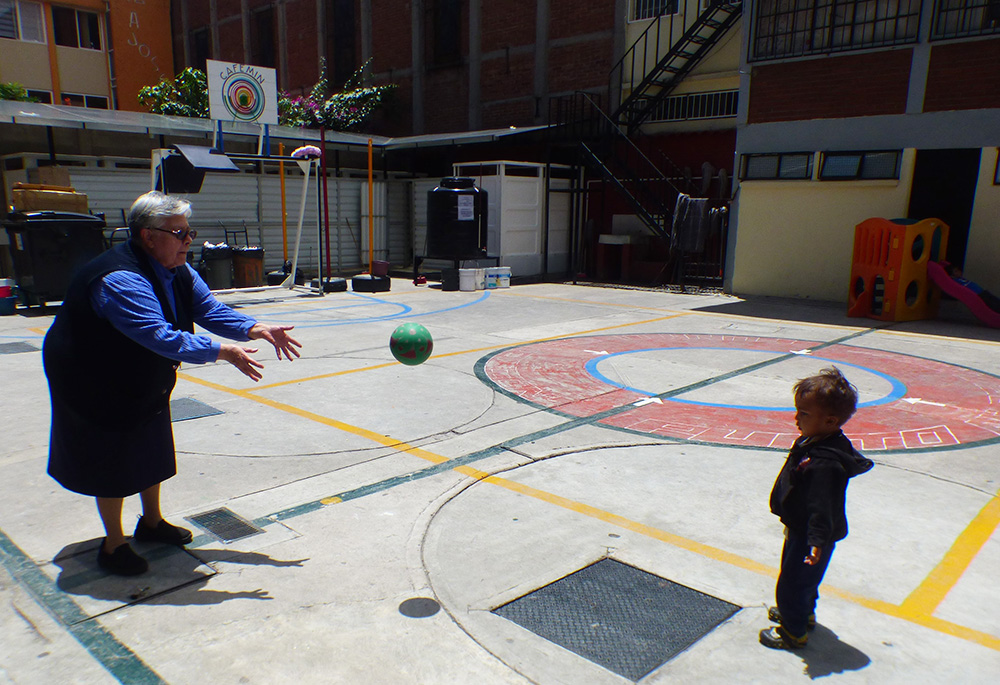
Josephine Sr. María Soledad Morales Ríos plays ball with a child Aug. 24, at the CAFEMIN shelter in Mexico City. For the past two years, the shelter her congregation operates, with a capacity to serve 100, has had to make room for up to 800 given the rising numbers of migrants passing through Mexico City. (GSR photo/Rhina Guidos)
"I came to run an errand last night and it was hard to walk" through the shelter because people covered almost every inch of the floor of the facility like a carpet, Josephine Sr. María Soledad Morales Ríos told Global Sisters Report during a tour of the shelter Aug. 24.
The bulk of the migrants that shelters like CAFEMIN see these days come from South America, and many have crossed the treacherous Darién Gap between Colombia and Panama in record numbers. Researchers Caitlyn Yates and Juan Pappier estimate that more than 81,000 crossed in August, "the highest number on record."
"Many people are being driven to leave their homes by factors such as repression and economic collapse in Venezuela, insecurity and political instability in Ecuador, and multiple crises in Haiti," they wrote in a paper published Sept. 20 for Migration Policy Institute.
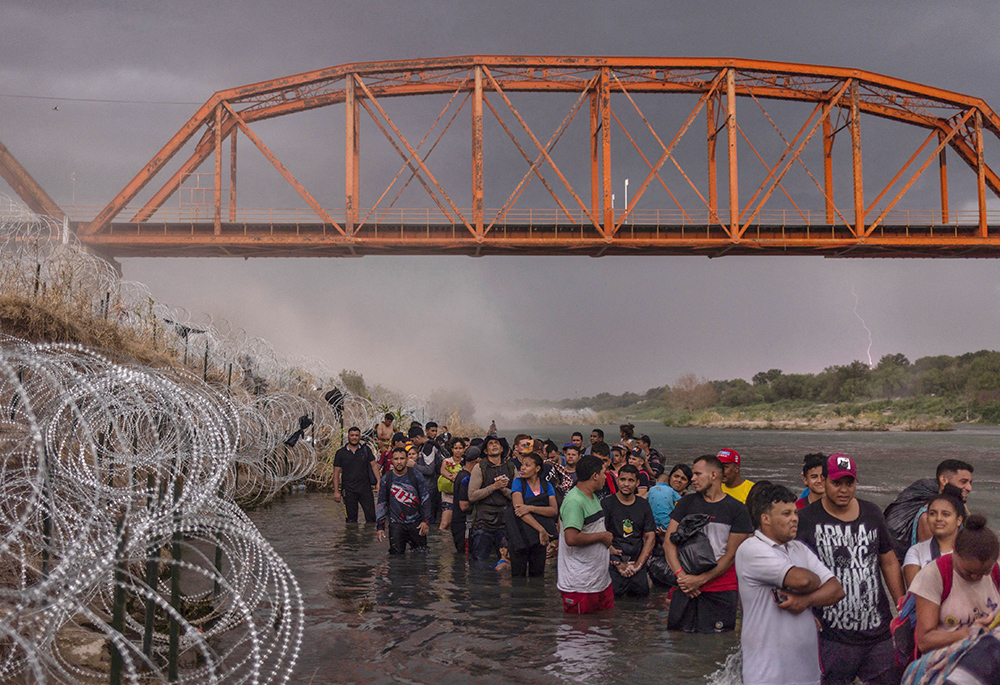
Lightning strikes and dust blows in the background from an incoming thunderstorm Sept. 15 as hundreds of migrants line up under the Puente Negro Ferrocarril train bridge and wait to surrender to authorities after wading across the Rio Grande from Mexico to enter the United States at Eagle Pass, Texas. (OSV News/Reuters/Adrees Latif)
The Biden administration has rolled out a variety of features trying to alleviate the bottleneck, including having asylum-seekers apply for entry using phone applications, such as CBP One, and regional "processing centers," where those who want to migrate can have their situation assessed to see if they qualify to enter the U.S. under a number of programs. But sometimes those tools become overwhelmed to the point that they collapse, Lizbeth Gramajo Bauer, of the Network of Jesuits with Migrants in Central America, told GSR during a seminar in Guatemala City Aug. 24.
The mixed results have helped some migrants travel safely and in an orderly manner, but others have grown desperate, said Verónica Juárez, project coordinator at CAFEMIN. Some take their chances, boarding the trains north toward border cities, encountering success crossing as well as tragedy.
A mural in the sisters' shelter features a train known as "the beast," painted by a man who boarded it and lost his leg in an accident while on it. An extension of the mural also depicts a long line of migrants carrying part of a long cross through the desert with a larger-than-life Jesus at the head of the line, as if leading them on the journey.
Advertisement
When the Josephines began their Mexico City effort to help migrants in 2012, they saw 30 to 40 people a day, Morales said. Up until the pandemic, there had been an ebb and flow, depending on regional events such as the 2018 political crisis in Nicaragua. With time, the Josephines expanded the shelter to welcome up to 100.
That came in handy, because even after the arrival of the pandemic, the Josephines never fully stopped responding to those asking for help. After the U.S. withdrew from Afghanistan in 2021 and those afraid for their lives fled to other countries, including Mexico, "we welcomed them," Morales said. When Russia attacked Ukraine in 2022 and Ukrainians ended up in Mexico en route to family members in the U.S., "we welcomed them, too," the sister said.
Google Translate was the only way to communicate with them, added Juárez.
But as coronavirus fears abated in 2021, the numbers began to climb. Since April of this year, it's rare to see the daily migrant intake drop to less than 800 a day.
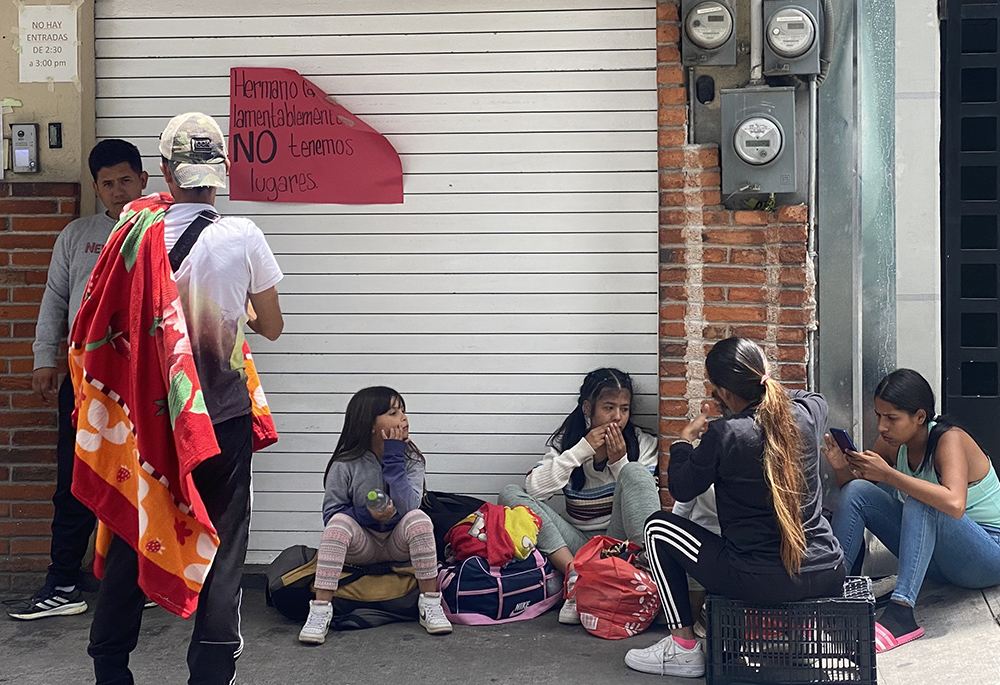
Migrants rest outside the CAFEMIN shelter in Mexico City, Aug. 24, near a sign on the door that says there is no more room inside. With the growing number of migrants heading toward the U.S., shelters along the route from South America to the U.S. southern border are beyond capacity to help. (GSR photo/Rhina Guidos)
Saturated. That's the word Morales used to refer to the space, which once had room set aside for offices and classrooms; now, many spaces do double duty as sleeping quarters at night.
"We're all in the same situation," she said of the other migrant shelters in the city. "Spaces for 30, 40 people, maximum, now have 100. We're all saturated. There's no way to send them somewhere else."
There are moments when the sisters decide that there really isn't room for anyone else, "and then you see a woman at the door with children, and it's raining, and you start looking for a corner" to put them in, she said.
The best they can do for the men sometimes is to let them sleep on the sidewalk, near the space close to the security guard at the shelter's entrance.
"Mexico, in general, is a country known for its hospitality," Juárez said.
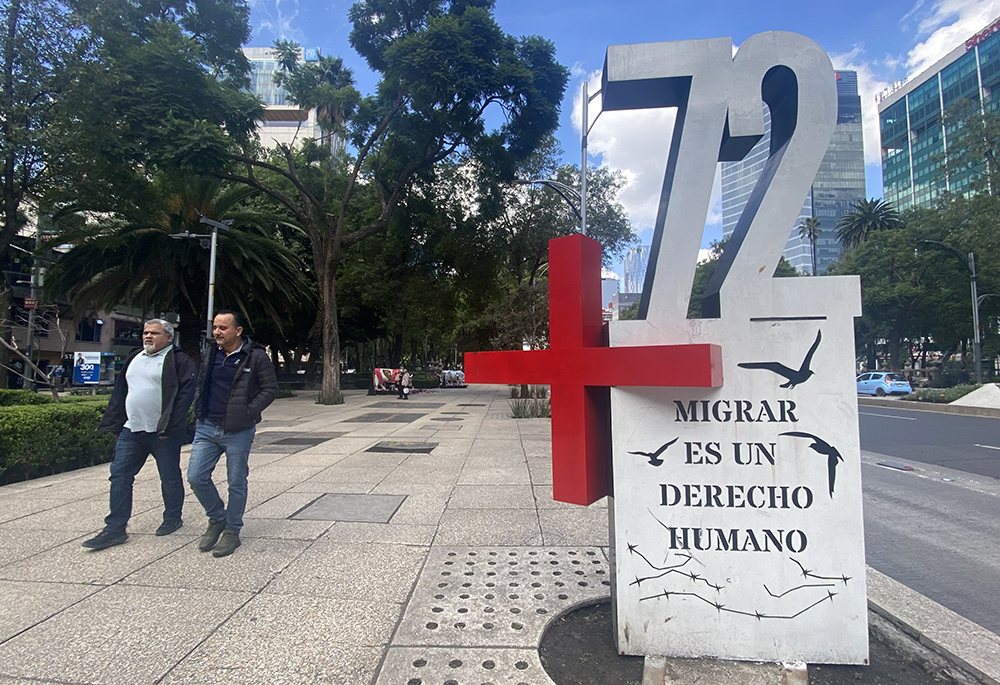
On the Paseo de la Reforma avenue in Mexico City, this memorial — with the words "migration is a human right" — honors 72 migrants massacred in southern Mexico in 2010. (GSR photo/Rhina Guidos)
The capital city's iconic avenue Paseo de la Reforma, the heart of Mexico City, features a memorial with birds in flight that says "no one is illegal in this world," and "migration is a human right."
But the recent waves of migrants are testing the limits of that hospitality, including near the shelter.
Juárez said the shelter's neighbors have taken to posting negative comments about the migrants on Facebook. Much of it seems to arise when places that typically help can no longer accommodate the burgeoning numbers, and people end up on the street.

Josephine Sr. Eloide Zavala weighs a migrant child at the CAFEMIN shelter in Mexico City, Aug. 24. With increasing problems in places such as Venezuela, Nicaragua and Haiti, migrants fleeing economic and political woes are facing backlash but find a warm welcome at shelters run by Catholic religious congregations. (GSR photo/Rhina Guidos)
The Josephines try to understand what the neighbors are feeling, Morales said, but all they can do is carry out the mission entrusted to them, one that gets harder as they struggle to squeeze bigger and bigger masses of people into their small space, to put more vegetables than meat into the soup so everyone can have enough to eat, as they pray for a life of dignity for them.
"The charism of the Josephines is to safeguard the lives of our brothers and sisters the way Joseph and Mary cared for Jesus," Morales said. "We want our house to be another Nazareth, where life is valued."
It's not an easy task when you see the immense need and you have so little, she added. And sometimes there's nothing left to give except your presence, she said, recounting the recent birth of a baby born at the shelter.
Sr. Magda Silva Rentería, the center's director, was the midwife, Morales recalled of the day when there was no time to take a migrant mother in the crowd, pregnant for the first time at 40, to the hospital when she went into labor prematurely.
"She had everything going against her," she said of the mother. "And there was Magda holding her. Well, that's how you sometimes live in fidelity to the mission of who we are in the church."






